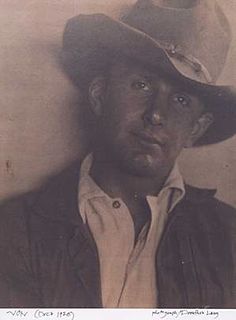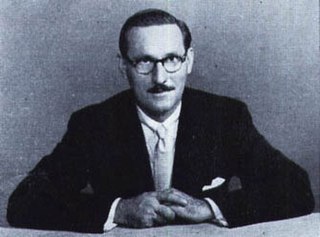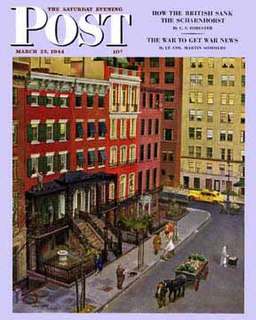
Norman Percevel Rockwell was an American painter and illustrator. His works have a broad popular appeal in the United States for their reflection of American culture. Rockwell is most famous for the cover illustrations of everyday life he created for The Saturday Evening Post magazine over nearly five decades. Among the best-known of Rockwell's works are the Willie Gillis series, Rosie the Riveter, The Problem We All Live With, Saying Grace, and the Four Freedoms series. He is also noted for his 64-year relationship with the Boy Scouts of America (BSA), during which he produced covers for their publication Boys' Life, calendars, and other illustrations. These works include popular images that reflect the Scout Oath and Scout Law such as The Scoutmaster, A Scout is Reverent and A Guiding Hand, among many others.

Anna Mary Robertson Moses, or Grandma Moses, was an American folk artist. She began painting in earnest at the age of 78 and is a prominent example of a newly successful art career at an advanced age. Her works have been shown and sold worldwide, including in museums, and have been merchandised such as on greeting cards. Sugaring Off was sold for US$1.2 million in 2006.

John Cullen Murphy was an American illustrator best known for his three decades of work on the Prince Valiant comic strip.

The Norman Rockwell Museum is an art museum in Stockbridge, Massachusetts, dedicated to the art of Norman Rockwell. It is home to the world's largest collection of original Rockwell art.

Frank Earle Schoonover was an American illustrator who worked in Wilmington, Delaware. A member of the Brandywine School, he was a contributing illustrator to magazines and did more than 5,000 paintings.
Richard Waring Rockwell was an American comic strip and comic book artist best known as Milt Caniff's uncredited art assistant for 35 years on the adventure strip Steve Canyon. Rockwell was a nephew of the famed painter and illustrator Norman Rockwell.

The Society of Illustrators is a professional society based in New York City. It was founded in 1901 to promote the art of illustration and, since 1959, has held an annual exhibition.

Albert Dorne was an American illustrator and entrepreneur, and was co-founder of correspondence schools for aspiring artists, photographers, and writers. Dorne was co-founder of the Code of Ethics and Fair Practices of the Profession of Commercial Art and Illustration.

Harold von Schmidt was an American illustrator, who specialized in magazine interior illustrations.

Al Parker (1906–1985) was an American artist and illustrator.

John Philip Falter, more commonly known as John Falter, was an American artist best known for his many cover paintings for The Saturday Evening Post.
The Famous Writers School was an educational institution that ran a correspondence course for writers in the 1960s and 1970s. Founded in 1961 by Bennett Cerf, Gordon Carroll, and Albert Dorne, it became the subject of a scandal after a 1970 exposé by Jessica Mitford, who noted the school's questionable academic and business practices.

Willie Gillis, Jr. is a fictional character created by Norman Rockwell for a series of World War II paintings that appeared on the covers of 11 issues of The Saturday Evening Post between 1941 and 1946. Gillis was an everyman with the rank of private whose career was tracked on the cover of the Post from induction through discharge without being depicted in battle. He and his girlfriend were modeled by two of Rockwell's acquaintances.

The Four Freedoms is a series of four 1943 oil paintings by the American artist Norman Rockwell. The paintings—Freedom of Speech, Freedom of Worship, Freedom from Want, and Freedom from Fear—are each approximately 45.75 inches (116.2 cm) × 35.5 inches (90 cm), and are now in the Norman Rockwell Museum in Stockbridge, Massachusetts. The four freedoms refer to President Franklin D. Roosevelt's January 1941 Four Freedoms State of the Union address in which he identified essential human rights that should be universally protected. The theme was incorporated into the Atlantic Charter, and became part of the charter of the United Nations. The paintings were reproduced in The Saturday Evening Post over four consecutive weeks in 1943, alongside essays by prominent thinkers of the day. They became the highlight of a touring exhibition sponsored by The Post and the U.S. Department of the Treasury. The exhibition and accompanying sales drives of war bonds raised over $132 million.

Lorraine Fox (1922–1976) was an American illustrator and commercial artist who illustrated magazines, book covers, and advertisements. Among the magazines she illustrated for were Woman's Day, Good Housekeeping, Redbook, McCall's, and Cosmopolitan. She was inducted into the Society of Illustrators' Hall of Fame in 1979.

Tom Lovell was an American illustrator and painter. He was a creator of pulp fiction magazine covers and illustrations, and of visual art of the American West. He produced illustrations for National Geographic magazine and many others, and painted many historical Western subjects such as interactions between Indians and white settlers and traders. He was inducted into the Society of Illustrators' Hall of Fame in 1974.

Edith Cleaves Barry (1884–1969) was an American sculptor, painter, illustrator and designer born in Boston Massachusetts. She studied at the Art Students League in New York City and with Frank DuMond and Richard E. Miller. Barry was the founder and served as the director of the Brick Store Museum in Kennebunk, Maine from 1936 to 1945.
The New Rochelle artist colony was a community of artists, actors, musicians, playwrights and writers who settled in the city of New Rochelle, New York, during the early twentieth century. By the 1920s, New Rochelle had more artists per capita than almost any city in the United States, and newspaper headlines were referring to the community as "Greenwich Village without the Greenwich."

Peter Wells was an American cartoonist and children’s book author and illustrator. He was also an instructor for the cartoon division of the Famous Artist School.
John Carlton Atherton was an American painter and magazine illustrator, writer and designer. His works form part of numerous collections, including the Museum of Modern Art, Whitney Museum of American Art and the Smithsonian American Art Museum.
















